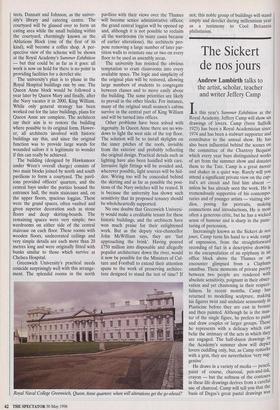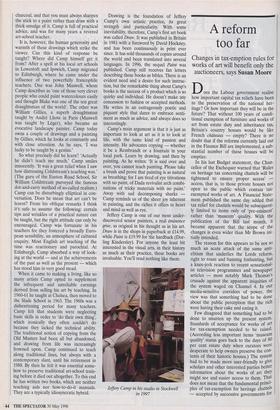The Sickert de nos jours
Andrew Lambirth talks to the artist, scholar, teacher and writer Jeffery Camp In this year's Summer Exhibition at the Royal Academy, Jeffery Camp will show six drawings of lovers. Camp (born Suffolk 1923) has been a Royal Academician since 1974 and has been a stalwart supporter and contributor to the annual show. He has also been influential behind the scenes on the committee of the Chantrey Bequest which every year buys distinguished works of art from the summer show and donates them to the Tate. Camp is a great mover and shaker in a quiet way. Rarely will you attend a significant private view on the cap- ital's art circuit and find him absent unless he has already seen the work. He is tremendously supportive of his contempo- raries and of younger artists — visiting stu- dios, posing for portraits, making connections and introductions, He is most often a generous critic, but he has a wicked sense of humour and is sharp in the punc- turing of pretension, Increasingly known as the Sickert de nos jours, Camp turns his hand to a wide range of expression, from the straightforward recording of fact in a descriptive drawing, to the encapsulation of an epiphany in an office block above the Thames or an encounter glimpsed from a Clapham omnibus. These moments of private poetry between two people are rendered with absolute sensitivity, poignant in their obser- vation and yet chastening in their respect- fulness. In recent months, Camp has returned to modelling sculpture, making his figures twist and undulate sensuously 111 Plasticine before they are cast in bronze and then painted. Although he is the mas- ter of the single figure, he prefers to paint and draw couples or larger groups. These he represents with a delicacy which can belie the intimacy of the acts in which they are engaged. The half-dozen drawings 10 the Academy's summer show will depict lovers cuddling only, but, as Camp remarks with a grin, they are nevertheless 'very sug- gestive'. He draws in a variety of media — pencil, paint of course, charcoal, pen-and-ink, crayon — but the softness of the contours in these life drawings derives from a careful use of charcoal. Camp will tell you that the basis of Degas's great pastel drawings was charcoal, and that you must always sharpen the stick to a point rather than draw with a thick smudge of it. Camp is full of practical advice, and was for many years a revered art-school teacher.
It is, however, the human generosity and warmth of these drawings which strike the viewer. Can this kind of response be taught? Where did Camp himself get it from? After a spell at his local art schools in Lowestoft and Ipswich, Camp migrated to Edinburgh, where he came under the influence of two powerfully francophile teachers. One was John Maxwell, whom Camp describes as 'one of those very clever people who could paint watercolours easily and thought Blake was one of the ten great draughtsman of the world'. The other was William Gillies, a superb draughtsman taught by Andre Lhote in Paris (Maxwell was taught by Leger), who became an evocative landscape painter. Camp today owns a couple of drawings and a painting by Gillies, which he looks at constantly and with close attention. As he says, 'I was lucky to be taught by a genius.'
So what precisely did he learn? 'Actually he didn't teach me much.' Camp smiles innocently. 'It was a great relief when I saw how distressing Coldstream's teaching was.' (The guru of the Euston Road School, Sir William Coldstream purveyed the famous dot-and-carry method of so-called realism.) Camp can be disturbingly elliptical in con- versation. Does he mean that art can't be learnt? From his oblique remarks I think it's safe to assume the following: certain tips and wrinkles of a practical nature can be taught, but the right attitude can only be encouraged. Camp was fortunate it his teachers for they fostered a broadly Euro- pean sensibility, an atmosphere of cultured enquiry. Most English art teaching of the time was reactionary and parochial. At Edinburgh, Camp absorbed a way of look- ing at the world — and at the achievements of the past as well as the present — which has stood him in very good stead.
When it came to making a living, like so many artists Camp opted to supplement the infrequent and unreliable earnings derived from selling his art by teaching. In 1960-61 he taught at Chelsea, then moved to the Slade School in 1963. The 1960s was a disheartening period for many teachers. Camp felt that students were neglecting basic skills in order to `do their own thing', which ironically they often couldn't do because they lacked the technical ability. The traditional notion of copying from the Old Masters had been all but abandoned, and drawing from life was increasingly frowned upon. Camp continued to teach along traditional lines, but always with a contemporary slant, until his retirement in 1988. By then he felt it was essential some- how to preserve traditional art-school train- ing before it died out altogether. To this end he has written two books, which are neither teaching aids nor how-to-do-it manuals. They are a typically idiosyncratic hybrid. Drawing is the foundation of Jeffery Camp's own artistic practice, its great strength and particularity. With some inevitability, therefore, Camp's first art book was called Draw. It was published in Britain in 1981 with a foreword by David Hockney, and has been continuously in print ever since. It has sold thousands of copies around the world and been translated into several languages. In 1996, the sequel Paint was published. Camp still receives fan letters describing these books as bibles. There is an evident need and a desire for such instruc- tion, but the remarkable thing about Camp's books is the success of a product which is so quirky and individual. He doesn't make any concession to fashion or accepted methods. He writes in an outrageously poetic and piquant style that dares to embrace senti- ment as much as advice, and always does so interestingly.
Camp's main argument is that it is just as important to look at art as it is to look at life, with the same kind of passion and intensity. He advocates copying — whether it be a Rembrandt or a fountain in your local park. Learn by drawing, and then by painting. As he writes: 'It is said over and over, you cannot teach painting. Please take a brush and prove that painting is as natural as breathing; for I am tired of eye titivations with no paint, of Dada revivalist arch combi- nations of tricky materials with no paint.' Away with sad decomposing sharks Camp reminds us of the sheer joy inherent in painting, and the riches it offers to heart and mind as well as eye.
Jeffery Camp is one of our most under- discovered senior painters, a real eminence gnse, as original in his thought as in his art. Draw is in the shops in paperback at £14.99, while Paint is £19.99 for the hardback (Dor- ling Kindersley). For anyone the least bit interested in the visual arts, in their history as much as their practice, these books are invaluable. You'll read nothing like them.
Jeffety Camp in his studio in Stockwell in 1997



































































 Previous page
Previous page